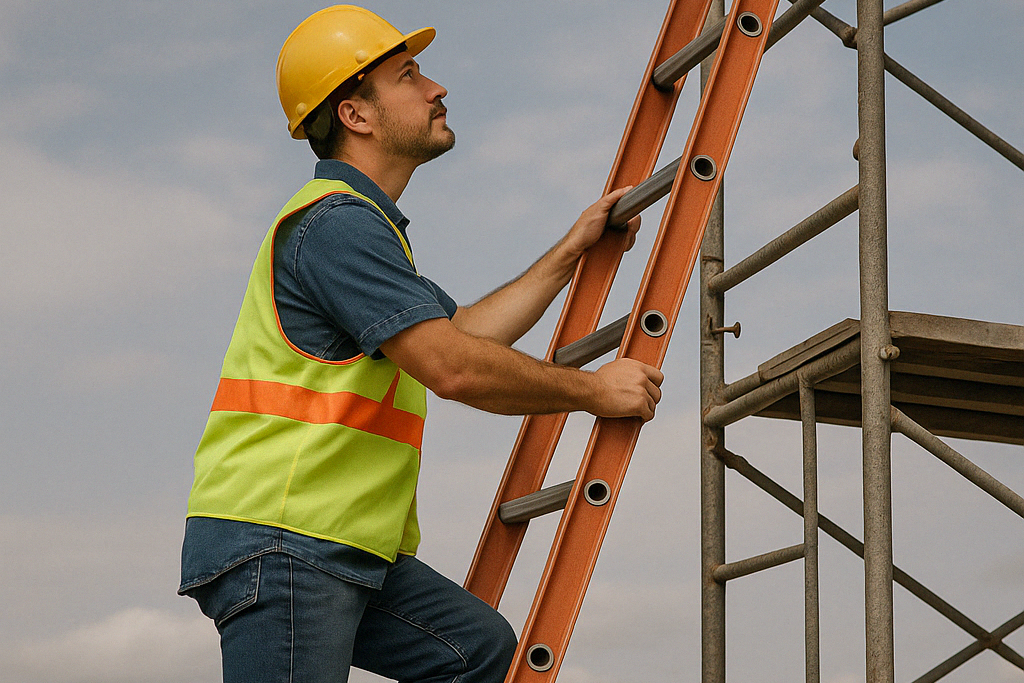Scaffold and ladder safety is a fundamental part of workplace injury prevention—especially in construction, maintenance, and industrial settings.
At the beginning of any job requiring work at heights, workers must be trained and equipped to use scaffolds and ladders safely. Falls from elevated work surfaces remain a leading cause of injuries and fatalities, making it critical to understand and apply proper safety practices.

Whether you’re on a job site or doing facility maintenance, knowing how to use scaffolds and ladders correctly can prevent serious incidents, regulatory penalties, and lost productivity.
The Importance of Scaffold and Ladder Safety
Ladders and scaffolds are essential tools for working at heights, yet they’re frequently misused. According to the Canadian Centre for Occupational Health and Safety (CCOHS), improper ladder use is one of the top causes of fall-related injuries. \
Similarly, scaffold collapses, tip-overs, and falls due to lack of guardrails or platform stability have led to severe incidents across industries.
By applying a proactive approach to scaffold and ladder safety, employers can significantly reduce risk, foster a safer environment, and comply with regulatory standards like CSA Z797 for scaffolding and OSHA guidelines for ladder safety.
Common Hazards When Using Scaffolds and Ladders

1. Falls from Heights
The most obvious and dangerous hazard. These incidents typically occur due to unsecured ladders, lack of fall protection, or unstable scaffold setups.
2. Structural Failures
Damaged or poorly constructed scaffolds can collapse under weight. Ladders that are cracked, bent, or missing steps also pose serious danger.
3. Electrocution
Using metal ladders near power lines or electrical systems without grounding or awareness is a major hazard.
4. Improper Use
Overreaching, standing on top rungs, or using ladders inappropriately can lead to sudden falls or tipping.
Choosing the Right Equipment for the Job
Selecting the appropriate ladder or scaffold is the first step to safety.
- Ladders should be selected based on height, load capacity, and task type (step ladders, extension ladders, platform ladders, etc.).
- Scaffolds should be engineered for stability and designed with adequate guardrails, toe boards, and platforms.
Internal safety training documents and your company’s health and safety management system (HSMS) should outline what equipment is approved and how it should be used.
Scaffold Safety: Best Practices
1. Inspection Before Use
Check for missing guardrails, planks, or tie-ins. Ensure footings are level and that the scaffold is secured.
2. Weight Limits
Never exceed the scaffold’s rated load capacity, including the weight of workers, tools, and materials.
3. Fall Protection
Use fall arrest systems when required. Guardrails must be installed at appropriate heights and properly secured.
4. Access and Egress
Ladders, stair towers, or ramps should be available and free from obstructions.
5. Weather Conditions
Avoid scaffold use during high winds, ice, or storms. Slippery surfaces increase fall risks.
Ladder Safety: Key Guidelines
1. Set-Up and Placement
Always place ladders on a firm, level surface. Extension ladders should follow the 4:1 rule (1 foot away from wall for every 4 feet in height).
2. Three Points of Contact
Always maintain two hands and one foot—or two feet and one hand—on the ladder at all times.
3. Avoid Overreaching
Keep your body between the rails. Overreaching can cause the ladder to tip.
4. Never Use the Top Rung
The top rung is not designed for standing. Use a ladder of appropriate height instead.
5. Portable Ladder Maintenance
Regularly inspect for cracks, corrosion, or missing feet and labels. Remove damaged ladders from service immediately.
Training and Competency
Employers must ensure that workers receive proper training before using scaffolds and ladders. This includes:

- Understanding weight ratings and safety features.
- Identifying hazards.
- Performing inspections.
- Emergency response procedures for falls or equipment failure.
Resources like OHSE.ca provide valuable training materials and courses to improve worker competency in scaffold and ladder use.
Internal Controls and Safety Culture
Organizations should integrate ladder and scaffold safety into their Occupational Health and Safety Management System (OHSMS). This includes:
- Job Hazard Analysis (JHA) before working at heights.
- Regular audits and safety walkthroughs.
- Signage, posters, and toolbox talks focused on fall prevention.
- Involving workers in safety planning to improve compliance and culture.
Explore additional PPE reminders and workplace safety articles, like 100 PPE Reminders That Could Save a Life, to reinforce good practices.
Conclusion: Protecting Workers at Heights
Scaffold and ladder safety is everyone’s responsibility. By following best practices, selecting the right equipment, and ensuring workers are trained and competent, employers can drastically reduce the risk of falls and injuries.
Safety doesn’t have to be complicated—it starts with knowledge, planning, and execution. A well-trained workforce, supported by strong safety leadership, can make working at heights a routine task, not a risky one.

No comments yet